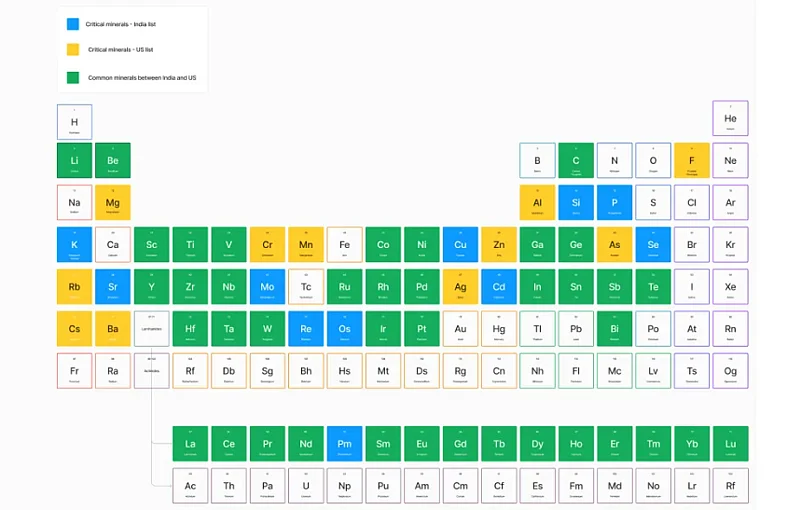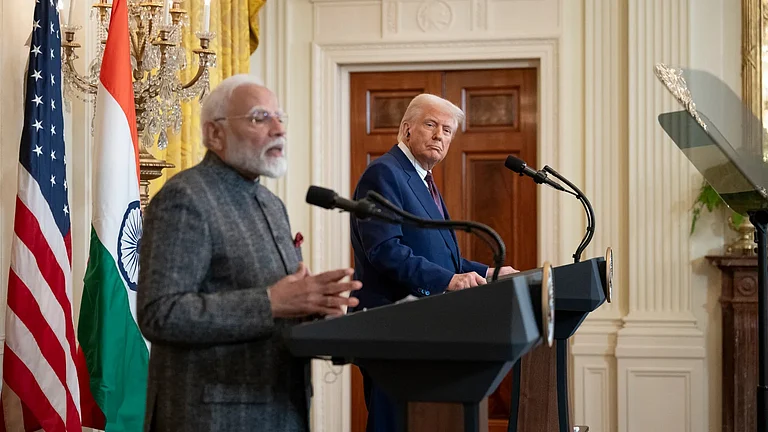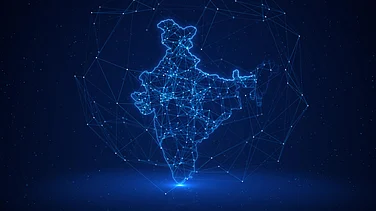In a significant cooperation that would aid growth of semiconductor technology, India and US have agreed to launch a ‘strategic mineral recovery’ initiative.
This is a new US-India programme to recover and process critical minerals including lithium, cobalt and rare earths from heavy industries like aluminum, coal mining and oil and gas, a joint statement after a bilateral meeting between US President Donald Trump and PM Narendra Modi.
This aims at accelerating collaboration in research and development and promoting investment across the entire critical mineral value chain, as well as through the Mineral Security Partnership, of which both the United States and India are members.
India-US Strategic Alliance
Critical minerals are a crucial part of the India-United States (US) bilateral partnership with developments such as the Initiative on Critical and Emerging Technologies (iCET) and the signing of the recent (October 2024) Memorandum of Understanding (MoU) on critical minerals supply chains. The MoU is one of few examples of India’s bilateral cooperation on critical minerals. It aims to leverage ‘the two countries’ complementary strengths to ensure greater resilience in the critical minerals sector’.
The India-US partnership is increasingly focused on developing closer ties through technology and clean energy cooperation in the critical minerals sector. Some priority areas of the MoU therefore include ‘identifying equipment, services, policies, and best practices to facilitate the mutually beneficial commercial development of US and Indian critical minerals’ along the global supply chains.
Growing demand for a clean energy transition is driving more countries to look for diversified supply sources for critical minerals.
The Importance
Critical minerals have emerged as a cornerstone of the growing India-US partnership, strengthening their energy, technology, and trade linkages. As India’s External Affairs Minister highlighted, both countries “value the strides we are making in our tech collaboration and economic partnership”.
Lithium and rare earth elements are crucial for modern energy storage solutions, particularly in electric vehicles (EVs) and renewable energy systems. They play a vital role in renewable energy technologies, advanced manufacturing, and digital infrastructure, with rare earth elements being essential for permanent magnets used in wind turbines. These elements are also indispensable for various high-tech applications, including electronics, defense systems, and clean energy technologies. In healthcare, rare earth elements are used in medical imaging technologies like MRI machines, while lithium batteries power life-saving medical devices, including implantable devices such as pacemakers. The growing demand for rare earths and lithium has driven economic growth by stimulating exploration, mining activities, and international trade. Recognizing the strategic significance of these elements, nations are increasingly focused on securing stable supply chains to ensure sustained progress.
There are four factors driving India-US cooperation on critical minerals: (1) America’s deepening international partnerships in this sector, (2) the 80% overlap between the critical minerals identified by India and the US, (3) the shared history of India-US clean energy partnerships, and (4) the developing national security and technology collaborations between the two partners.
American policy thinking on critical minerals can be seen to develop after the 2010 Chinese export ban on Japan of crucial minerals needed for semiconductors and automobiles over maritime disputes.
Out of the 50 critical minerals identified by the US in its list of critical minerals (2022), 40 of them overlap with India’s list of critical minerals (2023). There is an 80% overlap between minerals identified by both countries showcasing potential for cooperation, especially in third geographies such as Africa. This is because many of the minerals identified are Platinum Group Metals or Rare Earth Elements (REEs), which are geographically located in Africa. India also has deposits of various REEs such as thorium and light REEs such as neodymium, praseodymium, dysprosium, and terbium. International collaborations, such as the one between Indian Rare Earth Limited (IREL) and Toyotsu Rare Earth India Limited (subsidiary of Toyoto Tsusho Corporation, Japan), has significant potential for India and the US to further strengthen collaboration for mutual benefit.

Expanding cooperation in sectors like emerging technologies and (AI also underscores the involvement of cooperation on critical minerals. The iCET, which has been identified as a crucial policy development in furthering the India-US strategic partnership, is chaired by the key players in the national security establishment in the two countries. Showcasing that strategic thinking on critical minerals spills over into sectors beyond clean energy. Exemplifying this, India’s National Security Advisor, Ajit Doval has stated that there is “immense potential that is yet to be explored and harnessed in terms of deeper technology cooperation” between India and the US.
Reserves in India
Earlier in June 2023, India joined the US-led MSP, a coalition of 14 countries that seeks to drive public and private investments in critical mineral supply chains worldwide.
In a joint statement on 23 June 2023, India and the US reiterated their commitment to work together to ensure their markets are well-supplied with the essential critical minerals, and pledged “to hasten bilateral collaboration to secure resilient critical minerals supply chains”, welcoming India into the grouping.
India’s entry into the MSP holds particular importance, as one of New Delhi’s central growth strategies involves a major shift towards electric vehicles in both public and private transportation sectors.
Additionally, India's focus on electronics manufacturing and semiconductors underscores the necessity of securing critical mineral supplies.
India's inclusion in the MSP in 2023 followed a concerted diplomatic effort by New Delhi, amid concerns within the Indian government over its initial exclusion from the strategic initiative aimed at reducing dependence on China for critical minerals. These concerns were amplified when the partnership, which was launched in mid-2022, was expanded to include Italy in early 2023.
The MSP is said to have considered collaboration on around 150 projects, eventually shortlisting a dozen, including creating a critical minerals and metals cooperation forum for sharing of expertise, developing battery materials, and jointly developing a minerals processing facility in South America.
The MSP grouping is reportedly focused on the supply chains of minerals such as cobalt, nickel, lithium and also the 17 “rare earth” minerals. Cobalt, nickel, and lithium are essential for electric vehicle batteries, while rare earth minerals, in trace amounts, are crucial for semiconductors and advanced electronics.
India has reserves of some rare earth elements like lanthanum, cerium, neodymium, praseodymium, and samarium. However, heavy rare earth elements such as dysprosium, terbium, and europium are not found in extractable quantities in Indian deposits.
At present, there is a heavy reliance on China for heavy rare earth elements, as it produces around 70 per cent of the global supply.































